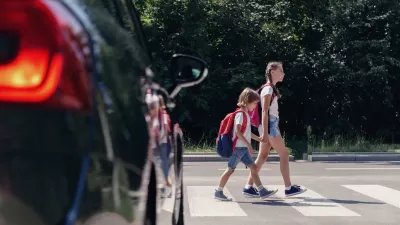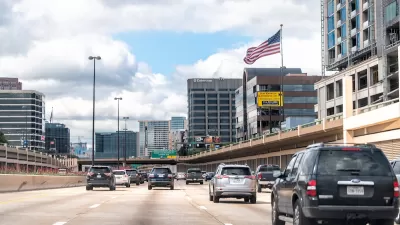Signs and markings designed for traffic control can make conditions less safe for pedestrians and other road users.

Writing in Streetsblog, Kea Wilson explains how the regulations codified in the Manual on Uniform Traffic Control Devices (MUTCD) can make roads less safe.
“Since the very first center line appeared on a Michigan road in 1911, many have questioned whether the design norms that govern the U.S. transportation network really make roads ‘safe,’ or simply less dangerous than the anarchic days of early motordom — though they're still nowhere near as safe as the days before the car dominated American roads at all.”
As transportation engineer Ian Lockwood explains, “The [signs, signals and markings in the] MUTCD aren't there to make our streets safer … They’re there to make them faster.” Signs and markings are designed to speed up traffic, and are less necessary at slower speeds. Cities that have experimented with removing signage and markings have seen positive results. “In 2016, transportation engineers in London found that when they removed center lines from several 30 mile-per-hour roads, traffic speeds and potential crash severity plummeted — perhaps validating Lockwood's hypothesis that the yellow line deserves some of the blame for traffic violence on U.S. roads, too.”
The concept known as Shared Space was pioneered by Dutch traffic engineer Hans Monderman, “who famously — if counter-intuitively — advised communities throughout Europe and Australia facing safety challenges to remove streetlights, lane markers, and even crosswalks, rather than following conventional wisdom that would have them install even more of them.” Lockwood adds that a misplaced faith in technology can cause people to behave less cautiously. “The lower tech we go, the more we have to drive responsibly.”
Despite proven increases in actual safety, pedestrians can perceive Shared Space interventions as making streets less safe. Removing physical curbs can also impede mobility for people with visual impairments who use curbs to identify where the sidewalk ends, for example.
But the ideology behind Shared Space—the belief that roads should be safe for all people—can be a useful approach for shifting focus away from trying to influence driver behavior with signage and designing safer roadways in the first place.
FULL STORY: Counter-Intuitive Department: Sometimes, Traffic Controls Make Streets More Dangerous

Alabama: Trump Terminates Settlements for Black Communities Harmed By Raw Sewage
Trump deemed the landmark civil rights agreement “illegal DEI and environmental justice policy.”

Planetizen Federal Action Tracker
A weekly monitor of how Trump’s orders and actions are impacting planners and planning in America.

The 120 Year Old Tiny Home Villages That Sheltered San Francisco’s Earthquake Refugees
More than a century ago, San Francisco mobilized to house thousands of residents displaced by the 1906 earthquake. Could their strategy offer a model for the present?

LA’s Tree Emergency Goes Beyond Vandalism
After a vandal destroyed dozens of downtown LA trees, Mayor Karen Bass vowed to replace them. Days later, she slashed the city’s tree budget.

Sacramento Leads Nation With Bus-Mounted Bike Lane Enforcement Cameras
The city is the first to use its bus-mounted traffic enforcement system to cite drivers who park or drive in bike lanes.

Seattle Voters Approve Social Housing Referendum
Voters approved a corporate tax to fund the city’s housing authority despite an opposition campaign funded by Amazon and Microsoft.
Urban Design for Planners 1: Software Tools
This six-course series explores essential urban design concepts using open source software and equips planners with the tools they need to participate fully in the urban design process.
Planning for Universal Design
Learn the tools for implementing Universal Design in planning regulations.
Ada County Highway District
Clanton & Associates, Inc.
Jessamine County Fiscal Court
Institute for Housing and Urban Development Studies (IHS)
City of Grandview
Harvard GSD Executive Education
Toledo-Lucas County Plan Commissions
Salt Lake City
NYU Wagner Graduate School of Public Service





























